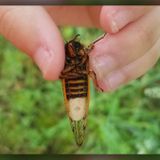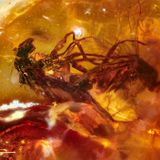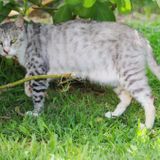RECENT ARTICLES

Mind-controlling fungus makes zombie cicadas lure other cicadas to a zombie fate
Live Science is supported by its audience. When you purchase through links on our site, we may earn an affiliate commission. .Male infected by a particularly gruesome parasitic fungus become with an undercover mission: They broadcast a female's sexy come-hither message to other male cicadas, luring their unsuspecting victims to join the zombie cicada horde.Researchers recently discovered this unusual twist to the cicada's already horrific zombification story. As the parasitic fungus called Massospora eats away at a cicada's abdomen, replacing it with a mass of yellow spores, the also...…Live Science is supported by its audience. When you purchase through links on our site, we may earn an affiliate commission. .Male infected by a particularly gruesome parasitic fungus become with an undercover mission: They broadcast a female's sexy come-hither message to other male cicadas, luring their unsuspecting victims to join the zombie cicada horde.Researchers recently discovered this unusual twist to the cicada's already horrific zombification story. As the parasitic fungus called Massospora eats away at a cicada's abdomen, replacing it with a mass of yellow spores, the also...WW…

1.5 billion-year-old Earth had water everywhere, but not one continent, study suggests
TrendingLive Science is supported by its audience. When you purchase through links on our site, we may earn an affiliate commission.Water, water, everywhere.(Image: © Shutterstock)What did look like 3.2 billion years ago? New evidence suggests the planet was covered by a vast ocean and had no continents at all.Continents appeared later, as thrust enormous, rocky land masses upward to breach the sea surfaces, scientists recently reported.They found clues about this ancient waterworld preserved in a chunk of ancient seafloor, now located in the outback of northwestern Australia. Related:...…TrendingLive Science is supported by its audience. When you purchase through links on our site, we may earn an affiliate commission.Water, water, everywhere.(Image: © Shutterstock)What did look like 3.2 billion years ago? New evidence suggests the planet was covered by a vast ocean and had no continents at all.Continents appeared later, as thrust enormous, rocky land masses upward to breach the sea surfaces, scientists recently reported.They found clues about this ancient waterworld preserved in a chunk of ancient seafloor, now located in the outback of northwestern Australia. Related:...WW…

41 million-year-old insect sex romp preserved in amber
Live Science is supported by its audience. When you purchase through links on our site, we may earn an affiliate commission. .About 41 million years ago, two long-legged flies had just begun an amorous tryst when they were caught fast in sticky sap, which eventually hardened around their joined bodies to form an amber tomb.The last moments of these mating flies, now locked in amber, offer a fascinating window into life in (around 55 million to 34 million years ago), which is part of the Paleogene period. This remarkable "frozen behavior" is one of many amber specimens that scientists...…Live Science is supported by its audience. When you purchase through links on our site, we may earn an affiliate commission. .About 41 million years ago, two long-legged flies had just begun an amorous tryst when they were caught fast in sticky sap, which eventually hardened around their joined bodies to form an amber tomb.The last moments of these mating flies, now locked in amber, offer a fascinating window into life in (around 55 million to 34 million years ago), which is part of the Paleogene period. This remarkable "frozen behavior" is one of many amber specimens that scientists...WW…

'Mind-control' cat parasite has now reached Hawaii's parks
Live Science is supported by its audience. When you purchase through links on our site, we may earn an affiliate commission. .Toxoplasma gondii, a "mind-controlling" parasite that causes the disease , has been found in public lands in Oahu, Hawaii for the first time, researchers have discovered. Though this parasite was previously found in people and in wildlife on the Hawaiian islands, it was unknown in Oahu's parks. And it hitchhiked there in free-ranging cats, which are a non-native species and are known hosts of the parasite. Thanks, cats.Though, to be fair, cats aren't really to...…Live Science is supported by its audience. When you purchase through links on our site, we may earn an affiliate commission. .Toxoplasma gondii, a "mind-controlling" parasite that causes the disease , has been found in public lands in Oahu, Hawaii for the first time, researchers have discovered. Though this parasite was previously found in people and in wildlife on the Hawaiian islands, it was unknown in Oahu's parks. And it hitchhiked there in free-ranging cats, which are a non-native species and are known hosts of the parasite. Thanks, cats.Though, to be fair, cats aren't really to...WW…

Did men's beards evolve to absorb a punch to the jaw?
Live Science is supported by its audience. When you purchase through links on our site, we may earn an affiliate commission. .Full, luxurious beards are a sight to behold, and they may also serve a practical purpose — softening the impact of a punch to the jaw.Throughout history, flowing beards have been celebrated by cultures around the world as an emblem of social dominance and virility, much like the flowing mane of a dominant male .However, the thick hair of a lion's mane also protects a big cat's throat against a rival's lethal claws and teeth, scientists have said. And a dense beard...…Live Science is supported by its audience. When you purchase through links on our site, we may earn an affiliate commission. .Full, luxurious beards are a sight to behold, and they may also serve a practical purpose — softening the impact of a punch to the jaw.Throughout history, flowing beards have been celebrated by cultures around the world as an emblem of social dominance and virility, much like the flowing mane of a dominant male .However, the thick hair of a lion's mane also protects a big cat's throat against a rival's lethal claws and teeth, scientists have said. And a dense beard...WW…

Dogs are being trained to sniff out COVID-19 in humans
Live Science is supported by its audience. When you purchase through links on our site, we may earn an affiliate commission. .Scientists are training to identify COVID-19 by following their noses.A new program at the University of Pennsylvania's School of Veterinary Medicine (Penn Vet) is putting noses to the grindstone for disease detection. Researchers are working with dogs to see if the canines' superior sniffers can help with early detection of COVID-19 in humans. Dogs that can pinpoint the scent of COVID-19 could identify infection in , and could play a valuable role in...…Live Science is supported by its audience. When you purchase through links on our site, we may earn an affiliate commission. .Scientists are training to identify COVID-19 by following their noses.A new program at the University of Pennsylvania's School of Veterinary Medicine (Penn Vet) is putting noses to the grindstone for disease detection. Researchers are working with dogs to see if the canines' superior sniffers can help with early detection of COVID-19 in humans. Dogs that can pinpoint the scent of COVID-19 could identify infection in , and could play a valuable role in...WW…
- Total 6 items
- 1